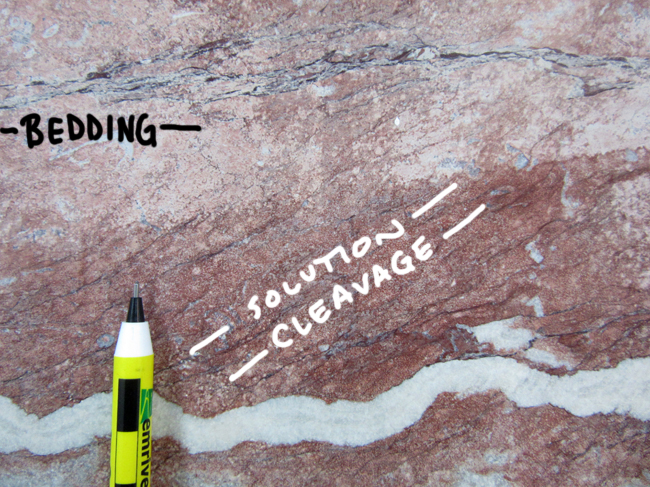While in Baltimore for the GSA meeting a few weeks ago, one morning (on my way to breakfast at Miss Shirley’s), I walked past a building and saw some cool geological features in the building stone used to face its exterior.
It was a coarse reddish limestone, at first glance kind of similar to “Tennessee Marble” such as may be seen on the interior of the National Air and Space Museum in Washington, DC, or the exterior of the National Museum of American History. It had lots of fossil chunks in it, including this crinoid:

Primary features such as bedding were clearly discernible, as well as mottled zones of what appeared to be bioturbation:

Here’s a zone that may represent primary sedimentary texture (rip-up clasts) or may be a little fault breccia:

There were also some clear tectonic overprints, including a pressure-solution-induced cleavage, marked by the accumulation of dark-colored insoluble material on the cleavage surfaces:


You can see how the pressure solution changed the shape of the crinoid, not so much by the elliptical cross-section, but by the flat upper left surface, parallel to the trace of cleavage:

Here is another nice example of bedding / cleavage relations in this lovely building stone:


So the overall story recorded by these slabs is: first, deposition of lots and lots of skeletal fragments of invertebrates (CaCO3) in an ancient, relatively high energy (coarse grain size) marine setting (based on the fossil content). It may have resembled a scene offshore from modern Florida. At times, the accumulation rate must have been moderate to slow (in order to get enough time for the bioturbation to occur). Periodically, storms may have pummeled these shallow waters (as hurricanes mash into Florida today) in order to make the rip-up clasts. Later, after lithification, the rock was squeezed under some sort of differential stress, oblique to bedding. This triggered pressure solution of the calcite, and allowed shortening of the fossils parallel to σ1, as well as the development of cleavage. Was this a tectonic compression? Maybe – if the bedding stayed in its original horizontal orientation. However, if the strata were rotated by 30° or so post-deposition, compaction under the force of gravity alone could explain the development of pressure solution seams ~parallel with horizontal, but oblique to bedding. Because I don’t see any of the “bed of nails” style of stylolites that are typical of such gravitational compaction (in say, the “Tennessee Marble”), I’m going with the tectonic cleavage interpretation as my leading hypothesis.
Gosh! Contemplating all that was better than coffee to wake a person up. I continued on my walk to breakfast thoroughly invigorated. One great thing about cities is they have lots of cool rocks on display, almost everywhere you look!
